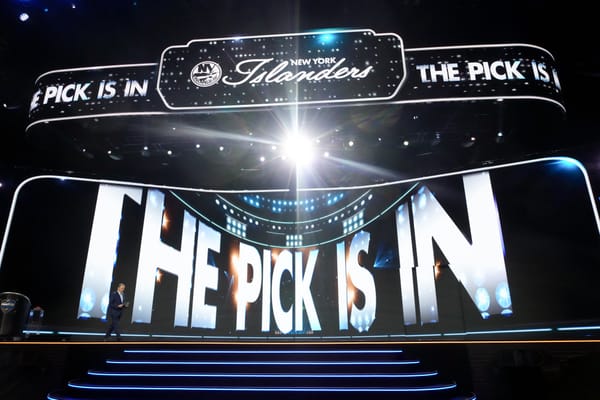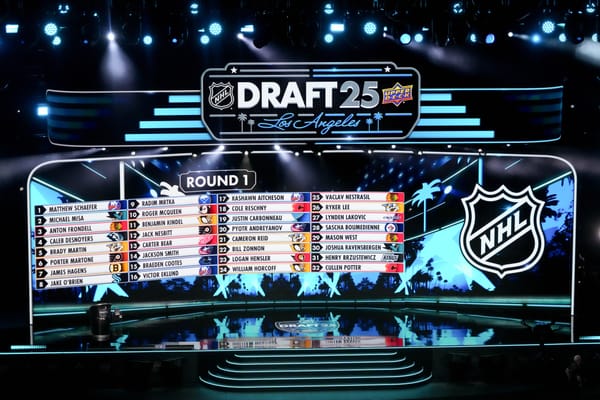What Is Mats Zuccarello’s Trade Value?
The Rangers announced intentions to rebuild, and warned fans that familiar faces could be on the move. Is Zuccarello the next to go?
The headline asks a basic question, but the answer varies depending on who you ask.
Before we get into the nitty-gritty details, here are a few basic facts surrounding Mats Zuccarello. On September 1, Zuccarello turns 31 and will be in the final year of a four-year, $18 million contract signed on March 2, 2015. His cap hit is $4.5 million and there are no clauses on his contract according to Cap Friendly.
This matters because players who are in their walk year carry less value than a player with term. The most obvious example is deals at the NHL trade deadline where rental players generally fetch a secondary or tertiary prospect, or a late first-round pick.
However, there are times when a team really wants a player and overspends, like when the Minnesota Wild traded for center Martin Hanzal from the Arizona Coyotes in exchange for a first-round pick in the 2017 NHL Draft, a second-round pick in 2018, a conditional pick in 2019 and forward Grayson Downing. Hanzal was a rental with a cap hit of $3.1 million and at the time he had 16 goals, and has 26 points in 51 games. You could even look at the Rangers’ trade of Rick Nash which is looking like a good haul at this point.
With that said, it is hard to pinpoint the exact trade value for a player like Zuccarello. He’s old(er), isn’t a star player and he lacks term. That doesn’t mean there isn’t a trade out there for him, and it also doesn’t mean the Rangers would just give him away.
Before looking at comparable trades, what has Zuccarello done of late which makes him worth acquiring in the first place?
I took a look at the last three seasons of play (2015-16, 2016-17 and 2017-17) and sorted for the top 50 forwards in categories such as even strength points, even strength primary points, all situations points, and all situations primary points. I also considered points and primary points per 60 by situation as well.
In the metrics looked at, Zuccarello was in the bottom half of the chart. If you are interested in 1 through 25 of any of the various stats, you can check this Google sheet out. Even though he’s in the bottom half, he’s keeping some good company.
2015 to 2018 5v5 Total Points
Zuccarello comes in at No. 30 which is pretty respectable. In totals he’s ahead of a few names including Tyler Seguin, Brandon Saad, Corey Perry, and Mike Hoffman among others.
While total points are great, what about primary points which filters out secondary assists?
2015 to 2018 5v5 Primary Points
Here Zuccarello slips a bit down to No. 33, but remains in front of some notable players which supports the notion of the Rangers’ winger being a force 5v5. In terms of rate stats, Zuccarello finished 42nd in points per 60 and 38th in primary points per 60.
While 5v5 production is very important to look at, and usually a good tool to use when evaluating whether or not results are repeatable, it’s still worth looking at how he’s performed in all situations.
2015 to 2018 All Situations Total Points
Here Zuccarello moves down to No. 42, but he still remains ahead of Jonathan Toews, Derek Stepan, and Nazem Kadri among others. Steven Stamkos only had 172 games played in this stretch, which explains why he’s lower down the list.
2015 to 2018 All Situations Primary Points
For primary points in all situations, Zuccarello dips to 45th, but is still ahead of players such as Henrik Zetternerg, Nazem Kadri, and Wayne Simmonds. In terms of rate stats, Zuccarello finished 45th in points per 60 and 48th in primary points per 60.
What these numbers tell us is that in the last three seasons, Zuccarello has been between the 30th and 48th best forward in the NHL in the categories measured. During the last three seasons 1,199 individuals appeared in at least one game as a skater. Depending on the chart you look at, if you put players into tiers, Zuccarello fell between the 95.99th to 97.49th percentile of players which is pretty good. If he’s been a 55 to 60 point player in New York, I can only imagine him on a team with someone who can consistently finish the passes he sends their way.
There’s always the element of regression which could hit Zuccarello in the coming years, and that’s why history suggests that they should trade him sooner rather than later. Part 1 and Part 2 of A New Look at Aging Curves for NHL Skaters from Hockey Graphs is something I’d suggest checking out if you are interested in a look at how player performance changes with age. There are always outliers like Martin St. Louis, but he’s a future Hall of Famer and the exception to the rule.
Now that we have a look at what Zuccarello has done, here are two trades I feel are somewhat comparable to the situation he is in.
Since the NHL is very much a “what have you done for me lately?” league, I am listing the most recent season of the player(s), with the exception of the second trade which featured a year of lockout production.
June 20, 2008: Montreal Canadiens Acquire Alex Tanguay and 2008 fifth round pick (No. 138) for 2008 first round pick (No. 25) and 2009 second round pick (No. 49)
Tanguay was 28 going on 29 with one year left on his contract worth $5.25 million coming off a season in which he had 58 points in 78 games for 0.74 points per game. With the Canadiens, he went on to appear in just 50 games adding 16 goals and 25 assists for 41 points. He then left for the Tampa Bay Lightning for a season before returning to the Calgary Flames.
Why It Is Comparable: The age, contract and production in year prior to being dealt are pretty much spot on. Zuccarello has a little more name recognition, his jersey was the 7th-most popular in 2017-18, and I think this is a good base to work off.
Current Day Equivalent: 2018 No. 13 overall
According to Michael Schucker’s NHL draft pick evaluation formula this pick is worth 481 points. The value of No. 25 and No. 49 from the Tanguay trade is equal to 488 points. By that logic, Tanguay was at the very least equal in value. While NHL general managers don’t usually consider that while making trades, this methodology still has some merit. You could spin the numbers to be picks 20 (350) and 88 (137), 23 (315) and 69 (174) or 26 (297) and 45 (192) and you would be within the range. That’s something more likely, but I will explain the concept of No. 13 (a low-chance situation which is specific to this year and team) in a little bit.
Ideally if given a choice, I feel the Rangers would look to do something for multiple picks as suggested above. They have found success outside the first round in the past, and they already hold onto three firsts in this years draft. However, I get the sense that the team would consider moving their own first rounder in a deal for a player if they are able to acquire another early-ish first rounder. Jeff Gorton indirectly said as much when speaking with Craig Custance of The Athletic.
“They can’t all be 18 (years old),” Gorton said. “You need different age groups to build your team.”
If the Rangers don’t win the lottery and move up to No. 1, No. 2 or No. 3, I think there is more value to be had from using the pick in order to try and add a younger player. The Arizona Coyotes acquired Antti Raanta and Derek Stepan for the No. 7 overall and Tony DeAngelo last year. I can’t see a reason why the Rangers wouldn’t try and move that pick and then deal off the roster to get another first in the teens.
The No. 13 currently owned by the Dallas Stars would fit that bill. While the team would be losing value here on paper, I think it would be hard for them to go all the way up to No. 9 which is worth 596 points using this framework. Some has suggested, mostly in jest, that the Rangers are next in line among tri-state teams to make a sweet deal with Edmonton Oilers GM Peter Chiarelli. While it is fun to joke about, I think in an ideal world, not the likeliest of scenarios for the record, that No. 13 is about as high as they could go dealing Zuccarello straight up. While there’s an argument that can be made that Zuccarello is worth more than Tanguay, I think comparatively speaking this is fair.
October 27, 2013: New York Islanders Acquire Thomas Vanek for Matt Moulson, 2014 first round pick and 2015 second round pick
Vanek was 29 turning 30 with a cap hit of $7,142,857 and heading to unrestricted free agency. The Buffalo Sabres couldn’t get a deal done in the summer and found a deal 13 games into their season. Vanek was coming off a lockout season in which he tallied 41 points in 38 games. His full season prior to that saw him tally 61 points in 78 games.
Matt Moulson was also 29 turning 30 with a cap hit of $3,133,333 heading toward free agency. He was coming off a lockout season that saw him tally 44 points in 47 games. The full year prior was a nice one as he set a career best with 36 goals, 33 assists and 69 points in 82 games. At the time the order of the draft picks were unknown. This trade was an interesting one as Vanek was traded by the Islanders after 47 games to the Montreal Canadiens at the trade deadline.
NYI say they do not have a contract extension in place with Thomas Vanek. He's UFA at the end of the season.
— Bob McKenzie (@TSNBobMcKenzie) October 28, 2013
When he was originally acquired it was known he was going to be a rental, but it was interesting to see him get traded instead of the Islanders trying to work out an extension. He would sign with the Minnesota Wild in free agency before getting bought out and becoming a bit of a journeyman.
Moulson was traded to the Wild along with Cody McCormick after 44 games for Torrey Mitchell, a 2014 second round pick, and a 2016 second round pick. He ultimately re-signed with the Sabres in the offseason, but has regressed each and every year since.
Why It Is Comparable: Vanek’s production with the Sabres is higher than Zuccarello’s, and for that reason any trade modeled off this swap would include an adjustment, likely the removal of the second round pick. He just so happened to be the most notable player closest in age and situation to Zuccarello who was traded recently.
One difference is that Vanek’s contract was something that limited the Sabres options when it came to trading him, an issue the Rangers wouldn’t have with Zuccarello. If a bidding war broke out that would give the Rangers more options. If made available, I think there’s at least a handful of teams that would love to add him for the season with an option to re-sign.
Although the return in terms of players was a wash at the time on paper, it was clear that Moulson’s production was enhanced by playing with John Tavares in a big way. He went from being an AHL player to a 30-goal scorer after joining the Islanders. His contract going the other way helped facilitate the deal. From that point of view, the deal became more about the Sabres getting draft picks which is what the Rangers could prioritize as well. It was a bonus for the Sabres to get Moulson for monetary purposes which gave them the ability to flip him in a trade before signing him in free agency.
Current Day Equivalent
At the time of the trade, the draft picks were unknown, therefore I can’t use Schucker’s points system. My guess using the Vanek trade as a framework would be either a 2018 or 2019 first round pick. As said above, I think the team would prefer to add a young player using their own first, which would theoretically make them push for a 2018 first to replace the one hypothetically traded away. That said, there’s nothing wrong with getting a start on 2019, because as the team goes through the process there will be corresponding moves to be made and you can never have enough assets.
In terms of where the pick falls, my guess is that it would be around 20th overall or later because a team acquiring Zuccarello would be a contender looking to stock up as opposed to a team that missed the playoffs the year prior.
The other way to look at Zuccarello’s value is by looking at first round picks that have been traded at the draft for multiple draft picks. Here is a chart from 2005 to 2017 showing instances where a team acquired a first round pick in exchange for multiple draft picks.
In other words, if you say the Rangers should trade him for the No. 12 overall pick, is his value close to that of the No. 16 and No. 41 overall pick? A way to look at that is by using an evaluation of picks from 1990 to 2013 model by TSN’s Scott Cullen.
Generally, the ratings are as follows:
10 - Generational
9 - Elite Player
8 - First Line, Top Pair D
7 - Top Six Forward, Top Four D
6 - Top Nine Forward, Top Six D
5 - NHL Regular, 350+ NHL games
4 - Fringe NHLer, 200+ NHL games
3 - Very Good Minor Leaguer, 50-200 NHL games
2 - Minor Leaguer, under 50 NHL games
1 - 10 or fewer NHL games
Cullen found that at No. 12 the average rating was a 5.19 who has a 79.2% chance of appearing in more than 100 games, a 41.7% chance of being a top six forward and a 50 percent chance of being a fourth liner or worse. At No. 16 the numbers are 4.19, 66.7%, 20.8% and 70.8% respectively. For picks between 41 and 45 the numbers are 3.08, 40.8%, 12,5% and 73.3%
Using that criteria, it is fair to say that Zuccarello, an established top-six forward with a good amount of game left in him, would be a better return than say the No. 16 and No. 41 pick in a draft. Obviously this is team dependent and it matters what stage they are in whether it be contender, tweener, or basement dweller etc.
With that said, I’ll revisit my suggestion of Zuccarello for the No. 13 overall pick, which is held by the Dallas Stars. The Stars would have made the playoffs had they not collapsed by losing eight games in a row in the month of March. They finished with 92 points, three points behind the Colorado Avalanche who occupied the final wild card spot.
They could use an upgrade on the wing because outside of Jamie Benn and Alexander Radulov they had Tyler Pitlick Brett Ritchie and Mattias Janmark in the top six. Valeri Nichuskin however is expected to return from the KHL, but ideally the Stars would still want to add another winger.
The free agent market this year includes Rick Nash, Evander Kane, James van Riemsdyk and David Perron but right now the Stars have only have $17,670,000 in cap space with 13 players signed beyond this season. Zuccarello’s deal may be the easiest to add on, because I see Kane, JVR and Perron each getting at least $5 million or more. Nash will be less, but odds are he stays on the east coast. This doesn’t include a rise in salary cap but even if you were to add $3 million to make it a $78 million cap, that leaves Dallas about $2.58 million per player to get to a 21 player roster, $2.29 million per player for a 22 player roster and $2.06 million per player to get to a full 23 player roster.
The team is currently without a head coach, and by extension a direction, so there’s no way of knowing if Zuccarello would fit the system.Still, I certainly think he represents an upgrade, and a No. 13 overall pick would give the Rangers the opportunity to add a prospect who helps them in their rebuild. That pick, plus the return from their hypothetical trade of the No. 8 overall pick plus the later selections acquired from the Boston Bruins and Tampa Bay Lightning could put them in pretty good shape. All that said, again the No. 13 isn’t a high likelihood, but just a perceived fit that would be in line with the history of a prior trade fro a value perspective.
It is just one scenario that require a lot to happen, but I wanted to present a best case scenario that was at least plausible. With that said, Zuccarello can likely fetch a first a little later on in the round say around the 17 to 20 range, or a much later first and second round pick.
Even though I have just plotted out a scenario which could see Zuccarello moved for a number of returns, there’s always the chance he stays. To be honest what his future holds is a big question at this point.
Related
What does the future hold for Mats Zuccarello?
All of the reasons I cited as benefits for Zuccarello’s trade value are reasons why he can be valuable to the team. The wing depth as it stands is Chris Kreider, Zuccarello, Pavel Buchnevich, Ryan Spooner, Vladislav Namestnikov, Jimmy Vesey and Jesper Fast. If Kovalchuk were to enter the mix that could shake things up. Or if JVR took a massive discount to come home. Nash and Grabner may want to comeback too, but those are unknowns. Those unknowns could result in Zuccarello staying.
What the Rangers decide to do with Zuccarello certainly isn’t an easy decision. If they do have thoughts of trading him though, it’s wise to consider those now before limiting their options to next season’s trade deadline to ensure a valuable return While trade deadline rentals can get nice returns, the UFA class next summer is pretty hot for wingers.
Notable UFA Wingers July 1, 2019
| PLAYER | CURRENT AGE | POS | CAP HIT |
|---|---|---|---|
| Jordan Eberle | 27 | RW | $6,000,000 |
| Artemi Panarin | 26 | LW | $6,000,000 |
| Jeff Skinner | 25 | LW, RW | $5,725,000 |
| Blake Wheeler | 31 | RW | $5,600,000 |
| Jason Pominville | 35 | RW | $5,600,000 |
| Matt Moulson | 34 | LW | $5,000,000 |
| Mats Zuccarello | 30 | RW | $4,500,000 |
| Justin Williams | 36 | RW | $4,500,000 |
| Max Pacioretty | 29 | LW | $4,500,000 |
| Carl Hagelin | 29 | LW | $4,000,000 |
| Wayne Simmonds | 29 | RW, LW | $3,975,000 |
| Jakob Silfverberg | 27 | RW, LW | $3,750,000 |
| Anders Lee | 27 | C, LW | $3,750,000 |
| Eric Staal | 33 | C | $3,500,000 |
At times it becomes hard to separate the personality from the player. Adam wrote on that prior to the deadline. However the Rangers warned fans that changes were coming, and I just can’t shake this sense that Zuccarello is next.
If he does indeed move on he can do so holding his head high, as there’s a lot for him to be proud of. And if he stays, that’s equally fine. For now though the Rangers offseason moves on, and once the draft lottery is held on Saturday there will be a clearer picture of what direction they could head in.
Financial information via Cap Friendly. Data via Corsica and Hockey-Reference unless otherwise noted.





